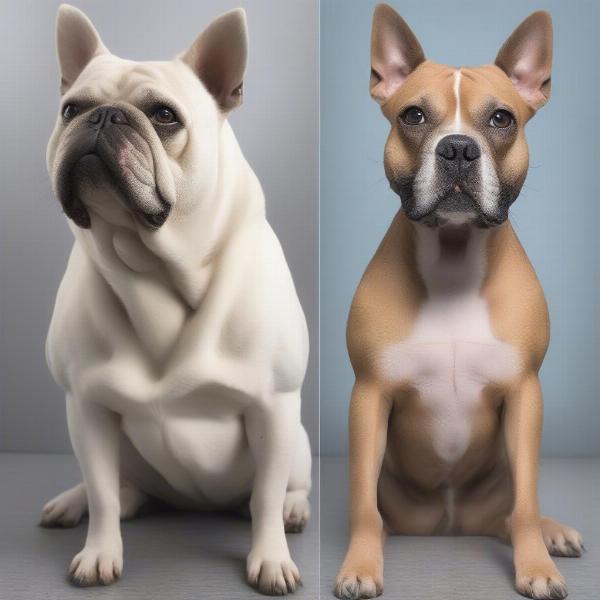Dog cosmetic surgery is a complex topic sparking debate among pet owners and veterinary professionals. While some procedures address genuine health concerns, others focus solely on aesthetics. This article explores the various types of dog cosmetic surgery, the potential benefits and risks, and the ethical considerations surrounding these procedures. We’ll delve into the reasons behind choosing cosmetic surgery for your dog, the crucial aspects to consider before making a decision, and the importance of prioritizing your dog’s overall well-being.
Understanding the Different Types of Dog Cosmetic Surgery
Cosmetic surgery for dogs encompasses a range of procedures, from ear cropping and tail docking to wrinkle reduction and dewclaw removal. Some procedures, like nostril widening for brachycephalic breeds, aim to improve breathing. Others, like skin fold reduction, can prevent infections. However, procedures like ear cropping and tail docking are primarily aesthetic and can be controversial due to their potential for unnecessary pain and suffering.
Weighing the Benefits and Risks of Dog Cosmetic Surgery
When considering dog cosmetic surgery, carefully weigh the potential benefits against the risks. While some procedures can significantly improve a dog’s quality of life by alleviating breathing problems or preventing infections, others carry risks of complications like pain, infection, and scarring. It’s essential to discuss these risks with your veterinarian and ensure the procedure is performed by a qualified and experienced surgeon.
 Before and After Dog Cosmetic Surgery
Before and After Dog Cosmetic Surgery
Is Dog Cosmetic Surgery Ethical? The Debate Continues
The ethics of dog cosmetic surgery remain a subject of ongoing debate. Many animal welfare organizations oppose procedures performed solely for aesthetic purposes, arguing they prioritize human preferences over the dog’s well-being. Others believe that if the procedure doesn’t harm the dog and potentially improves their quality of life, it’s an acceptable choice. It’s crucial to consider the ethical implications and make an informed decision based on your dog’s best interests.
Making an Informed Decision: Key Considerations Before Choosing Dog Cosmetic Surgery
Before opting for dog cosmetic surgery, thorough research and consultation with a trusted veterinarian are crucial. Consider your dog’s breed, age, health status, and the specific procedure’s potential benefits and risks. Ask yourself if the procedure is truly necessary for your dog’s well-being or primarily for aesthetic reasons. A responsible pet owner prioritizes their dog’s health and comfort above all else.
Alternatives to Cosmetic Surgery: Exploring Non-Surgical Options
In many cases, non-surgical alternatives can address cosmetic concerns. For example, proper grooming can prevent skin fold infections, and behavioral training can address tail chasing, sometimes eliminating the perceived need for tail docking. Explore these options with your veterinarian before considering surgery.
Post-Operative Care: Ensuring a Smooth Recovery for Your Dog
If you decide to proceed with dog cosmetic surgery, understanding and diligently following post-operative care instructions is vital. This includes pain management, wound care, and monitoring for any signs of complications. Your veterinarian will provide specific instructions based on the procedure performed.
Conclusion: Prioritizing Your Dog’s Well-being Above All Else
Dog cosmetic surgery can be a complex and emotionally charged decision. By carefully weighing the benefits and risks, considering ethical implications, and prioritizing your dog’s overall well-being, you can make an informed choice that’s in your dog’s best interest. Always consult with a trusted veterinarian to explore all available options and ensure your dog receives the best possible care.
FAQ
- Is dog cosmetic surgery painful? While pain management is a standard part of the procedure and recovery, some discomfort is inevitable.
- How much does dog cosmetic surgery cost? Costs vary depending on the procedure, the location, and the surgeon’s expertise.
- Are there any long-term effects of dog cosmetic surgery? Some procedures can have long-term effects, such as scarring or changes in behavior.
- What are the alternatives to ear cropping and tail docking? Alternatives include proper grooming and training.
- How do I choose a qualified surgeon for my dog’s cosmetic surgery? Consult with your veterinarian for recommendations and thoroughly research potential surgeons.
- What are the signs of complications after dog cosmetic surgery? Signs of complications include excessive swelling, bleeding, or discharge from the incision site.
- How long does it take for a dog to recover from cosmetic surgery? Recovery time varies depending on the procedure and the individual dog.
ILM Dog is your trusted resource for expert advice on all aspects of dog care, including breed selection, health, training, nutrition, grooming, and more. We’re dedicated to providing pet owners with reliable, practical information to help them make the best decisions for their furry companions. Whether you’re a seasoned dog owner or just starting your journey, we’re here to support you every step of the way. Contact us today for personalized guidance: Email: [email protected], Phone: +44 20-3965-8624. ILM Dog is committed to promoting responsible pet ownership and helping you nurture a happy, healthy relationship with your canine companion.